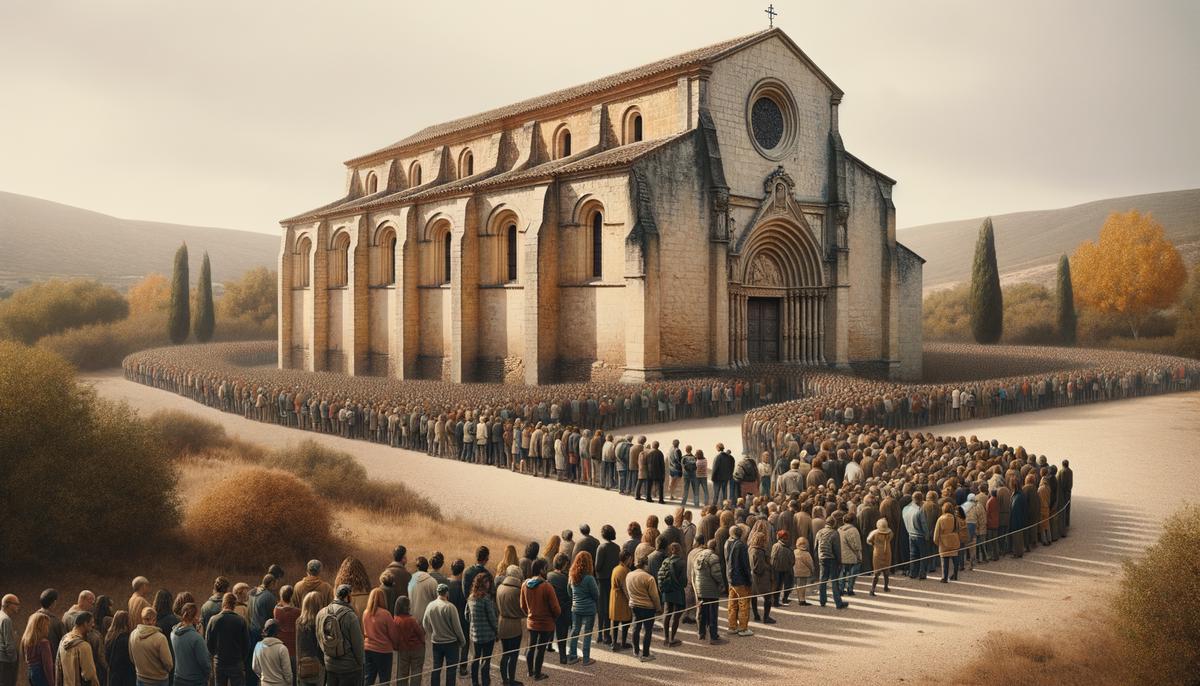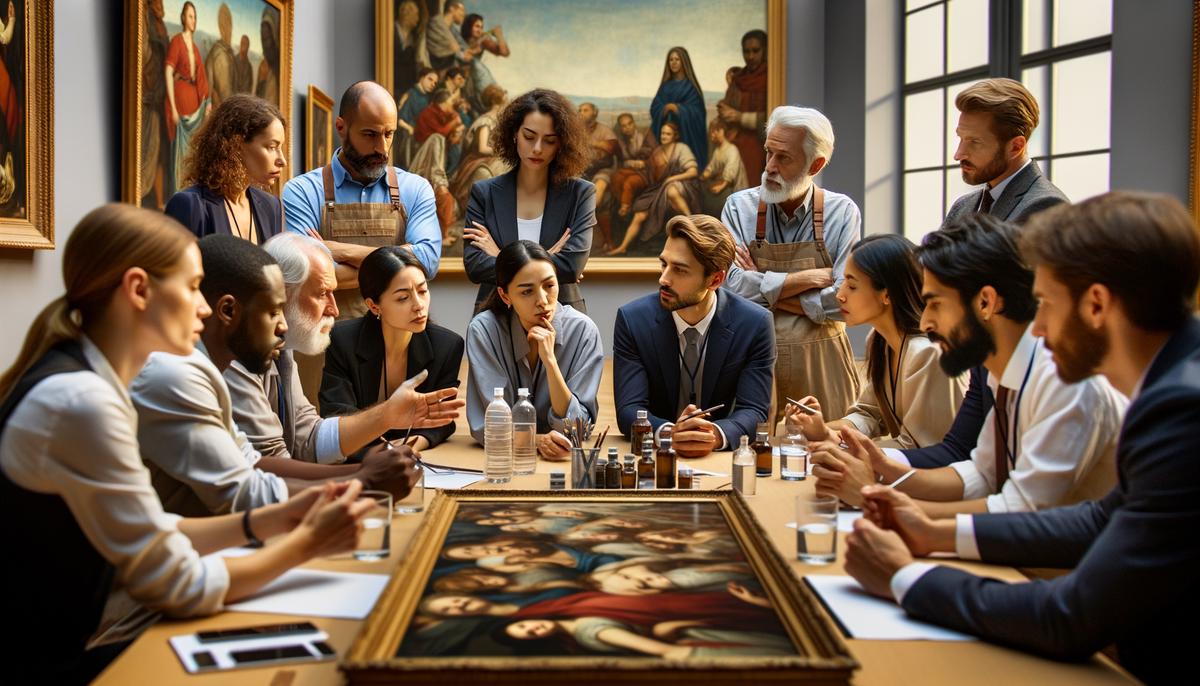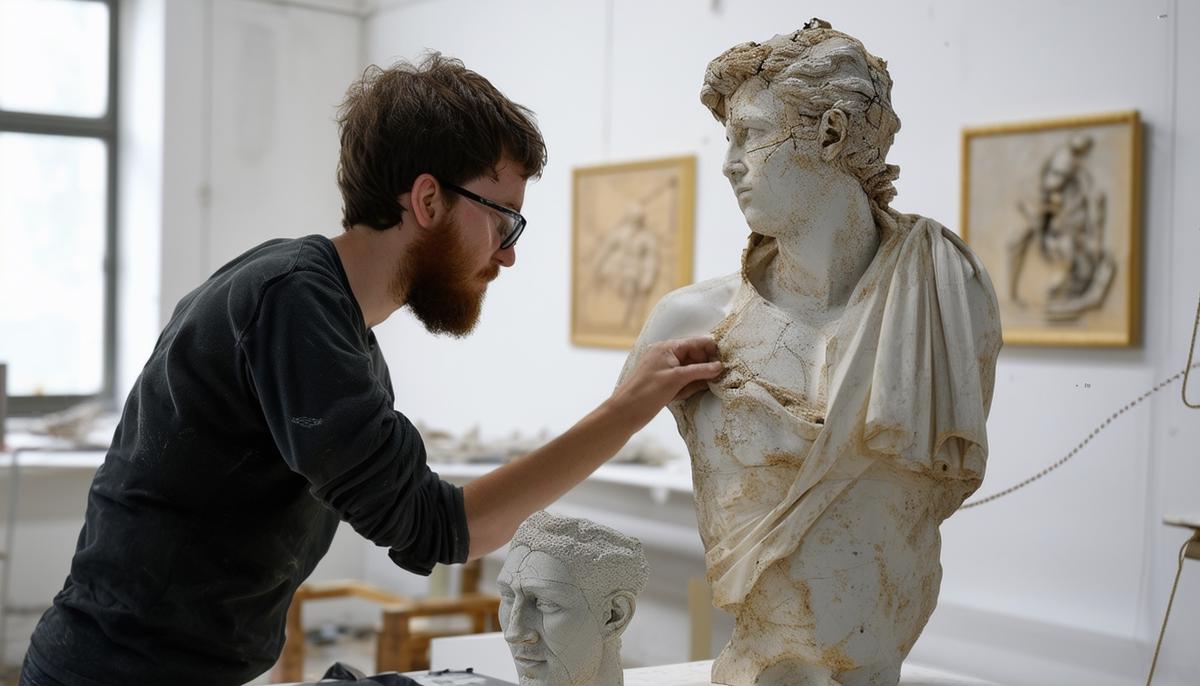Historical Context of Art Restoration
Art restoration has experienced significant shifts from its Renaissance origins to its twenty-first-century applications. During the Italian Renaissance, artists like Leonardo da Vinci and Michelangelo not only created but also restored art, breathing new life into centuries-old works.
As time progressed, the technique and philosophy of art restoration evolved alongside technological advancements and changing aesthetic values. The nineteenth century saw frequent attempts to return artworks to their perceived original state, often lacking the scientific rigor and historical accuracy demanded by current standards. This period witnessed liberal repaints and aggressive cleaning of old masters, practices that would later face scrutiny and criticism.
The twentieth century marked a pivotal turn as the focus shifted from restoration to conservation—a preservation-centric approach emphasizing stabilization and minimal interference. The heated debates surrounding the cleaning of the Sistine Chapel ceiling from 1980-1994 epitomized this philosophical evolution, sparking worldwide discourse on the integrity and authenticity of invasive restoration practices.1
Today, art restoration intertwines cutting-edge scientific research, ethical considerations, and a duty to preserve historical integrity while ensuring the artwork's future survival. Advanced imaging technologies like X-ray fluorescence and infrared reflectography allow conservators to reveal hidden layers and make informed decisions without physically altering the artworks. Digital tools and techniques, such as virtual reality simulations, enable public engagement and provide a kind of ethical 'test run' for restorations before any physical work is done.
Art restoration continues to balance delicately between art and science, inheritance and experimentation, history and modernity. Each era introduces new challenges and revelations, offering our global heritage a chance to revive and narrate its stories with a renewed voice, one careful stroke at a time.
Notable Failures in Art Restoration
Art restoration failures occur when good intentions collide with inadequate execution. The 2012 incident surrounding the Ecce Homo fresco in Borja, Spain, is a glaring example. Local amateur artist Cecilia Giménez attempted to restore the damaged fresco depicting Jesus crowned with thorns, but the result was a severely altered depiction that earned the nickname "Monkey Christ." This debacle sparked international ridicule and, paradoxically, a surge in tourism to Borja.2
Another case involves a statue of the Virgin and Child at the Ste Anne des Pins church in Sudbury, Ontario. After vandalism and theft of the baby Jesus' head, a local artist crafted a temporary replacement that clashed with the original limestone statue's delicate features. Eventually, a more sympathetic professional restoration aligned with the statue's original aesthetic.
These failures underscore the debate on qualifications and standards in art conservation:- The individuals involved lacked professional credentials, leading to methods and materials out of sync with established practices.
- Such incidents highlight the need for stringent qualification standards and better public awareness about the delicate balance art restoration must strike between preserving historical truth and ensuring structural stability.
Public and professional reactions have ranged from humor and fascination to outrage and exasperation. These episodes serve as crucial learning cases, stressing the importance of ethical responsibility, appropriate skill qualification, and ongoing public dialogue about conservation work within cultural heritage contexts.
Observing these failures as part of a broader narrative about cultural preservation provides valuable insights into the evolving standards and philosophies guiding art restoration today. Each mishap becomes a thread in the larger canvas of our shared cultural inheritance, offering cautionary tales as we move forward in the intricate dance of art conservation.
Impact of Failed Restorations on Public Perception
Failed restorations have sparked a range of emotions and reactions from the public, from bewilderment and amusement to concern about the stewardship of our artistic heritage. Each instance has a unique impact on the perception of art conservation and its role in cultural preservation.
The case of the Ecce Homo fresco in Borja, Spain, transformed an obscure religious artwork into a global sensation due to the botched restoration attempt. The viral nature of this failure turned Borja into an unexpected tourist hotspot, with thousands visiting the church to see the infamous "Monkey Christ" fresco. This phenomenon led to discussions about the "Ecce Homo Effect," where a failed restoration ironically boosts a site's popularity.
However, not all aftermaths have a positive twist. In cases where the failed restoration evokes a tragic sentiment, it may trigger a backlash, shaking public trust in art institutions tasked with conserving cultural treasures. The mishandled restoration of the iconic mask of Tutankhamun in Egypt led to widespread criticism and underlined the critical need for professionalism in art conservation.3
These high-profile restoration failures serve as a forum for public debates about cultural stewardship:- Who is qualified to undertake such sensitive work?
- How transparent should institutions be about their restoration methodologies?
The narrative spun from failed art restorations challenges museums, churches, and other cultural entities to reconsider their approach to public engagement. Demonstrating a commitment to best practices, clear communication regarding restoration policies, and showcasing successful restorations could help restore faith among viewers. Education also plays a crucial role, with some institutions offering seminars and workshops to provide insight into the complex work involved in art conservation.
These celebrated blunders impress upon current and future custodians of heritage the necessity to balance ambition with skill and ethical consideration. For every mishap that draws a crowd, there are countless untold stories of successful conservation efforts that maintain our vibrant historical canvas. These narratives provide powerful learning experiences that enrich our global dialogue on the evolving landscape of cultural preservation.

Regulatory and Ethical Considerations
Achieving balance between aesthetic fidelity and structural fortitude in art restoration involves careful craftsmanship and navigating a labyrinth of ethical dilemmas and regulatory frameworks. The restoration process inherently confronts an artist's original intent, the object's historical significance, and its contemporary interpretation, making every decision a potential point of ethical contention.
One central ethical quandary is the conflict between "authenticity" and "preservation." Should a restored artwork aim to reflect the artist's original design exactly or simply stabilize its current condition to prevent further deterioration? While restoring might renew a piece's visual splendor, excessive alteration may lead to accusations of distorting historical authenticity.
The distinctions illuminating these processes vary significantly across global landscapes:- Countries like Italy and France, rich in Renaissance and Baroque masterpieces, have rigorous academic training and regulated licensure processes anchoring art restoration efforts.
- These nations often enforce strict guidelines dictated by governmental bodies or organizations like ICOM (International Council of Museums) that provide standards adhering to both ethical and technical codes.
In response to glaring missteps in art restoration, there are rising calls for tighter controls and standardization of practices. Advocates argue for a model that includes rigorous training programs and an official accreditation system to underpin all operations by qualified professionals. ACRE (Association of Conservators-Restorers) in Spain, for example, campaigns for reforms that bind restoration activity strictly to accredited professionals.4
Transparency is another pressing issue. Stakeholders argue that restoration processes should be open to peer reviews and public scrutiny to ensure adherence to endorsed ethical standards and preservation of artistic integrity. This aligns with a broader intent to educate the public about the complex nature of restorations, transforming observers into informed participants in the narrative on art preservation.
As the art restoration community grapples with these layered issues, fostering a global discourse on uniform practices and maintaining a balance between revitalization and distortion remains imperative. Only by threading this intricate canvas of technical prowess, rigorous ethics, and holistic education will the field continue to honor the sanctity of artworks across eras while ushering them into continued relevance for future admiration.

Technological Advancements in Art Restoration
Emerging technologies revolutionize the field of art restoration, leveraging new tools such as digital imaging, 3D scanning, and printing to enhance accuracy and outcomes. These advancements hold substantial promise in minimizing errors that lead to restoration failures, pivoting the field towards a more innovative and fail-safe future.
Digital imaging techniques allow conservators to see beyond the visible surface, detecting underlying damages and the artist's original materials and techniques:- X-ray imaging
- Ultraviolet fluorescence
- Infrared reflectography
This invisible insight is invaluable, enabling a more informed approach to restoration that respects the artwork's original integrity.
3D technology further extends these capabilities. 3D scanning enables the creation of precise digital replicas of artworks that serve as reference models throughout the restoration process. 3D printing allows the reproduction of missing or damaged parts of sculptures and artifacts with high material fidelity and accuracy, ensuring that additions are accurate and reversible.
Advanced computer algorithms now assist in hypothetical restorations by simulating different repair strategies and predicting their long-term effects. Virtual restoration, where digital tools show how an artwork might look after various techniques are applied, can be immensely useful in planning restoration work, ensuring better choices are made before any physical intervention occurs.
These technologies democratize restoration by facilitating more engaging and educative dialogue with the public. Through interactive apps and augmented reality presentations, institutions can take viewers on a journey through the stages of an artwork's diagnosis, restoration planning, and envisaged results before any actual work is carried out, promoting a transparent process that can bolster public trust and appreciation.
While these technologies are promising, their integration into conservation practices is not without challenges. Ethical concerns arise regarding over-reliance on digital intervention, potentially masking the tactile nuances a seasoned conservator might perceive. Furthermore, the cost of cutting-edge technologies may be prohibitive, limiting their application to more affluent institutions or high-profile projects.
As the art restoration field embraces these technologies, ongoing calibration between technological possibilities and traditional conservation ethics will be key. As more professionals are trained in these new methodologies and costs gradually decrease, these innovative tools are predicted to become standard instruments in the conservator's toolkit. This evolution heralds a future where technology and tradition merge seamlessly to preserve artistic legacies with unprecedented precision and respect for original craftsmanship, significantly reducing the likelihood of future restoration failures.

The field of art restoration stands as both a technical challenge and an ethical imperative, balancing the preservation of artistic integrity with the adaptation to modern conservation methods. As this field continues to advance, the fusion of technology and traditional techniques will likely decrease the occurrence of restoration failures, ensuring that artworks continue to inspire and educate future generations in their most authentic forms.
- Daley J. Sistine Chapel ceiling opens to public. The Independent. 1994 Apr 9.
- Minder R. Despite Good Intentions, a Fresco in Spain Is Ruined. The New York Times. 2012 Aug 23.
- Aly R. Tutankhamun beard incident is a monument to our times. Financial Times. 2015 Jan 28.
- ACRE (Asociación de Conservadores-Restauradores de España). Professional Development. Accessed 2023.






















